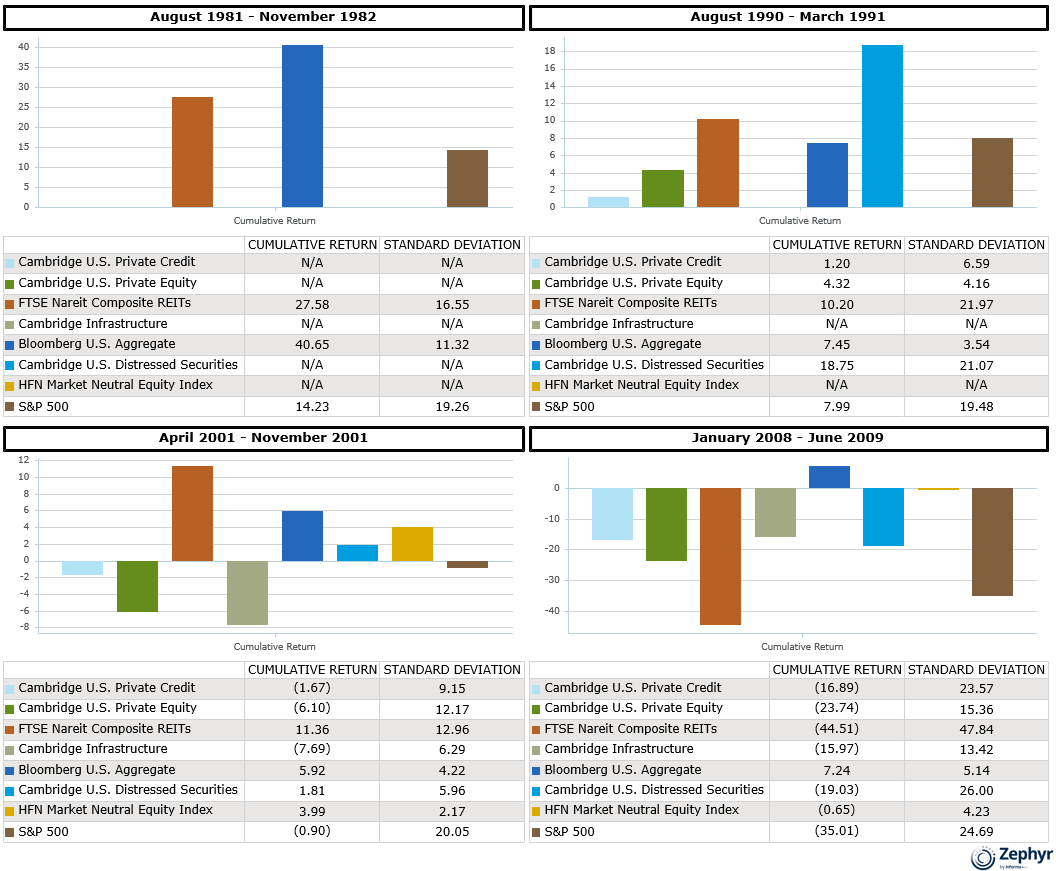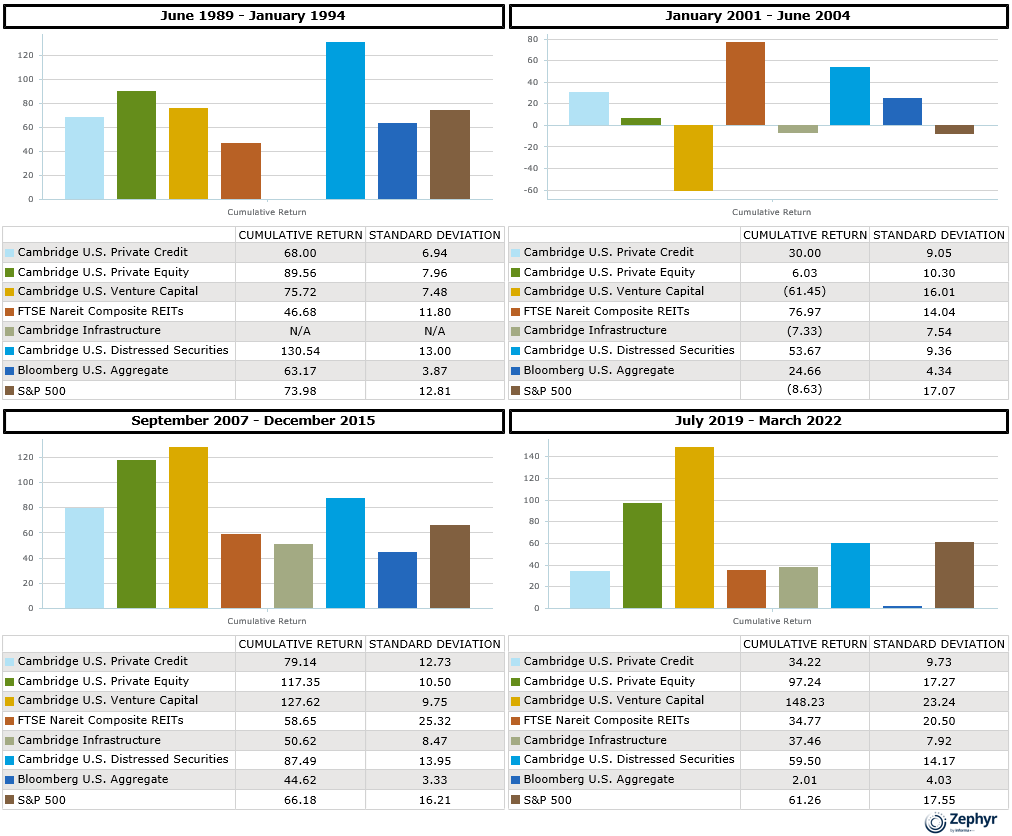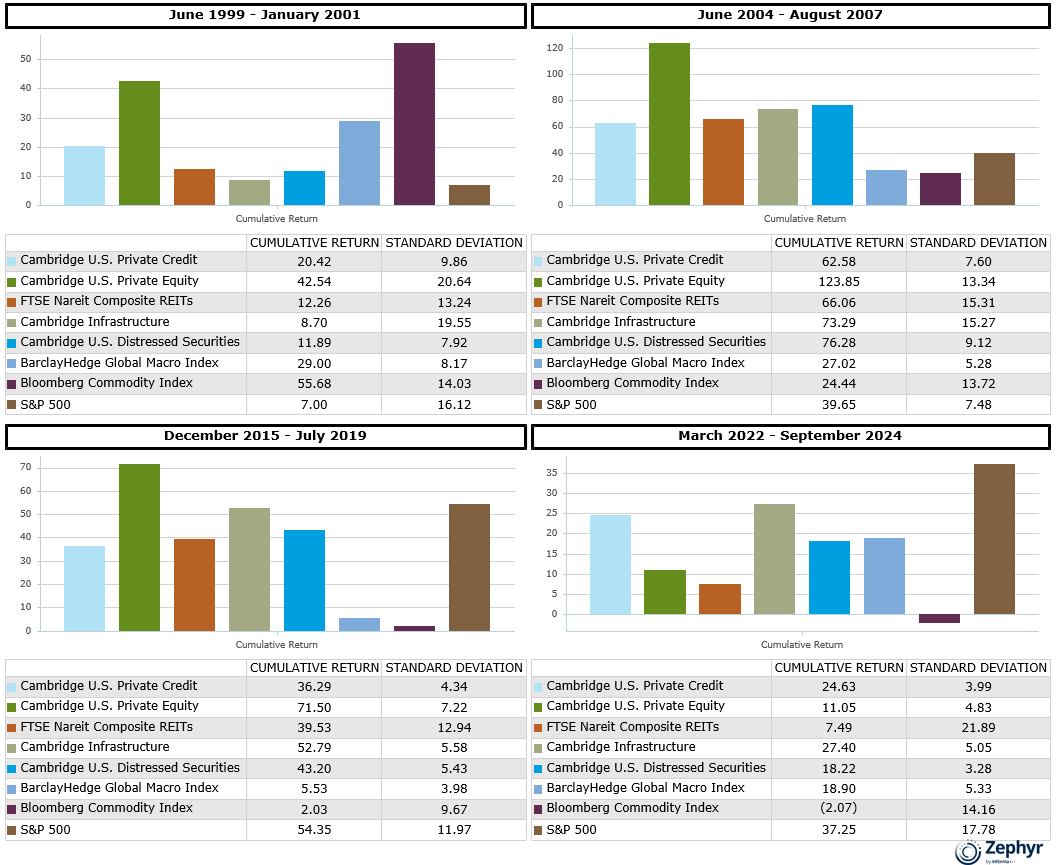Over the course of the next couple of months, I will take an in-depth look at alternative investments and the benefits, pitfalls and the role they play in asset allocations. In the second article of the series, I look at how different alternative investments perform during different market cycles. Read the first installment of the series titled “Exploring the World of Alternatives” here.
In today’s increasingly complex financial landscape, financial advisors face the challenging task of constructing investment portfolios that can weather various economic conditions while meeting clients’ long-term objectives. Alternative investments have become essential components of sophisticated investment portfolio construction. But how do these alternatives perform during different macroeconomic cycles? Below we explore the macroeconomic environments that tend to favor different alternative asset classes.
Understanding Alternative Investments in the Economic Cycle
Alternative investments encompass a diverse range of assets including private equity, hedge funds, real estate, commodities, infrastructure, and private debt. Each category responds differently to economic conditions, making them valuable tools for diversification beyond traditional market correlations.
Looking for more information about the different types of alternative investments? We have you covered.
Inflationary Environments
Inflationary environments are at the top of the list for good reasons as elevated inflation is fresh on the mind of investors as the Federal Reserve continues its quest to tame 40-year high prices. While inflation creates a challenging environment for fixed income, equities tend to perform well. Meanwhile, during inflationary periods, alternative investments often demonstrate their value (Figure 1).
Real Assets shine during inflationary cycles. Real estate, infrastructure, and commodities have historically served as effective inflation hedges because they represent tangible assets with intrinsic value. Commercial real estate with inflation-indexed lease agreements can pass through rising costs to tenants. Infrastructure investments like toll roads, utilities, and airports often have contractual inflation adjustments built into their revenue models.
Commodities typically perform well during inflationary periods as rising prices directly benefit raw materials producers. Energy commodities, industrial metals, and agricultural products can see significant appreciation when inflation accelerates, particularly during supply-constrained environments.
Private Credit strategies with floating-rate structures can benefit from rising interest rates that often accompany inflation. As central banks raise rates to combat inflation, these investments automatically adjust their yields upward, unlike fixed-rate bonds which suffer price declines.

Figure 1 – Source: Zephyr
Recessionary Environments.
Economic contractions present different opportunities for alternative investments while the overall performance of different asset classes remains a mixed bag. It’s important to consider the underlying factors that push the economy into a recession when looking for asset classes that might help stabilize your client’s portfolios (Figure 2). Note – due to the unique nature and very short duration, the Covid-19 recession is not included.
Zephyr can help financial advisors get a better understanding of the impact different market cycles have on investments. Find out more here.
Distressed Debt strategies typically find their moment and provide a good portfolio diversifier during economic downturns. As corporate defaults rise and traditional capital sources retreat, specialized managers can acquire debt at significant discounts, positioning for recovery value or restructuring opportunities that emerge during the subsequent economic healing.
Market-Neutral Hedge Funds that focus on relative value and arbitrage opportunities rather than directional market exposure can provide valuable portfolio stability during market turbulence. Their ability to generate alpha independent of market direction becomes particularly valuable when traditional assets face synchronized declines.

Figure 2 – Source: Zephyr
Low-Interest Rate Environments
Overall, most assets perform well during interest rate cutting cycles and periods when central banks maintain accommodative monetary policies (time periods extend from the first rate cut to the first rate hike). Private equity, venture capital and distressed securities tend to outperform public equities during these periods (Figure 3).
Private Real Estate and Infrastructure investments become particularly attractive as investors search for yield. The income component of these investments, often featuring stable cash flows from long-term leases or contracts, provides an appealing alternative to low-yielding fixed income.
Private Equity benefits from cheap financing for leveraged buyouts and corporate expansion. Lower borrowing costs enhance returns on invested capital and facilitate larger transactions.
Outside of the years immediately following the dot-com bubble bursting, Venture Capital thrives in low-rate environments as capital becomes readily available for growth-stage companies, and investors demonstrate greater willingness to fund early-stage enterprises with longer paths to profitability.

Figure 3 – Source: Zephyr
High-Interest Rate Environments
In what may surprise some, most alternatives asset classes perform well, including public equities during periods of tighter monetary policies (time periods extend from the first rate hike to the first rate cut) (Figure 4).
Private equity strategies benefit from high interest rates as multiples tend to decrease, creating opportunities to acquire good assets at discounted prices. Private equity strategies have performed well during the last four high-interest rate environments. In fact, private equity strategies have outperformed public equities during three of the four cycles.
Private Credit strategies focused on senior secured lending can offer attractive risk-adjusted returns as higher base rates flow through to overall yields, while maintaining seniority in the capital structure provides downside protection.
Real Assets with inflation-protection features continue to perform well, particularly those with strong pricing power and limited competition.

Figure 4 – Source: Zephyr
Conclusion
Alternative investments have evolved from optional portfolio components to essential elements of modern wealth management. Their ability to perform differently across macroeconomic environments—often when traditional investments struggle—makes them valuable diversification tools for financial advisors seeking to construct resilient investment portfolios for their clients.
The most successful implementation approach recognizes that no single alternative strategy works in all environments. Instead, thoughtfully constructed alternative allocations across multiple strategies can help smooth the investment journey through economic cycles while potentially enhancing risk-adjusted returns.
As fiduciaries, financial advisors who develop expertise in alternative investments position themselves to deliver more comprehensive wealth management solutions that address clients’ needs across all economic environments—from inflation to recession, and from low rates to high rates reshaping our economic landscape.
Zephyr, is an award-winning asset and wealth management software that offers portfolio construction, proposal generation, advanced analytics, asset allocation, manager screening, risk analysis, portfolio performance and more, transforming multifaceted data into digestible intel.
Ryan Nauman is the Market Strategist at Zephyr, which helps investment professionals make more informed investment decisions on behalf of their clients. Connect with Ryan on Linkedin.
#Alternative #Investments #Macroeconomic #Cycles